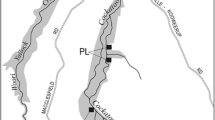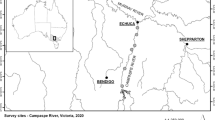Abstract
Understanding the role of seed banks can be important for designing restoration projects. Using the seedling emergence method, we investigated the soil seed banks of two montane, deciduous riparian forest ecosystems of southeastern Arizona. We contrasted the seed banks and extant vegetation of Ramsey Canyon, which is the site of riparian restoration activities, with that of Garden Canyon, which has been less affected by human land uses. Fewer plant species were found at Ramsey Canyon than Garden Canyon, for both the seed bank and extant vegetation, and the vegetation at Ramsey Canyon (seed bank and extant) had consistently drier wetland indicator scores. As well, vegetation patterns within sampling zones (channel margins and adjacent riparian forests) differed between canyons. At Garden Canyon channel margins, the seed bank and extant vegetation had relatively high similarity, with herbaceous wetland perennial species dominating. Extant vegetation in the floodplain riparian forest zone at Garden Canyon had a drier wetland indicator score than the seed bank, suggesting that the floodplains are storing seeds dispersed from wetter fluvial surfaces. Vegetation patterns for Ramsey Canyon channel margins were similar to those for Garden Canyon floodplains. Vegetation patterns in the Ramsey Canyon riparian forest zone were indicative of non-flooded conditions with an abundance of upland species in the soil seed bank and extant vegetation. Channel geomorphology measurements indicated that much of the riparian forest zone at Ramsey Canyon is functionally a terrace, a condition that may be a legacy of channel erosion from historic land uses. Steep, erodible channel slopes may contribute to the low seed bank germinant density at Ramsey Canyon channel margins, and narrower flood-prone area may explain the greater terrestrialization of the vegetation in both sampling zones. We recommend testing the use of donor soils from more diverse stream reaches to restore biodiversity levels at Ramsey Canyon, following restoration activities such as channel-widening. Seed banks from Garden Canyon, for example, although predominantly consisting of herbaceous perennials, would supply species with a range of moisture tolerances, life spans, and growth forms. We also recommend that restorationists take care not to harm seed banks exposed during removal of introduced species; at Ramsey Canyon, soil seed banks were equally diverse in areas with high and low cover of the introduced Vinca major (a legacy of Ramsey Canyon land use).
Similar content being viewed by others
References
V.J. Abernethy N.J. Willby (1999) ArticleTitleChanges along a disturbance gradient in the density and composition of propagule banks in floodplain aquatic habitats Plant Ecology 140 177–190
O.W. Archibold D. Brooks L. Delanoy (1997) ArticleTitleAn investigation of the invasive shrub European buckthorn, Rhamnus cathartica L., near Saskatoon, Saskatchewan. Canadian Field Naturalist 111 617–621
M.G. Barbour J.H. Burk W.D. Pitts (1999) Terrestrial Plant Ecology Benjamin/Cummings Menlo Park, California
C.C. Baskin J.M. Baskin (1998) Seeds: Ecology, Biogeography, and Evolution of Dormancy and Germination Academic Press New York
Boudell J. and Stromberg J.C. Role of seed banks in maintaining biodiversity in a riparian ecosystem: Hassayampa River, Arizona (in preparation).
J.E. Bowers S.P. McLaughlin (1996) ArticleTitleFlora of the Huachuca Mountains, a botanically rich and historically significant sky island in Cochise County, Arizona Flora of the Huachuca Mountains, Cochise County, Arizona-Nevada Academy of Sciences 29 66–107
M.K. Briggs (1996) Riparian Ecosystem Recovery in Arid Lands The University of Arizona Press Tucson, Arizona
D.E. Brown (Eds) (1994) Biotic Communities: Southwestern United States and Northwestern Mexico University of Utah Press Salt Lake City, Utah
S.C. Brown B.L. Bedford (1997) ArticleTitleRestoration of wetland vegetation with transplanted wetland soil: an experimental study Wetlands 17 424–437
D.J. Burke (1997) ArticleTitleDonor wetland soil promotes revegetation in wetland trials Restoration and Management Notes 15 168–172
I.C.S. Combroux G. Bornette C. Amoros (2002) ArticleTitlePlant regenerative strategies after a major disturbance: The case of a riverine wetland restoration Wetlands 22 234–246
J.T. Curtis R.P. McIntosh (1951) ArticleTitleAn upland forest continuum in the prairie-forest border region of Wisconsin Ecology 32 476–496
A.F.J. Deiller M.N. Walter M. Tremolieres (2001) ArticleTitleEffects of flood interruption on species richness, diversity and floristic composition of woody regeneration in the upper Rhine alluvial hardwood forest Regulated Rivers–Research and Management 17 393–405
Desert Research Institute, Western Regional Climate Center 2001. Historic climate information [online]. Reno, Nevada, USA.Available at http://www.wrcc.dri.edu (verified 29 July 2002).
C.M. Finlayson I.K. Cowie B.J. Bailey (1990) ArticleTitleSediment seedbanks in grassland on the Magela Creek floodplain, northern Australia Aquatic Botany 38 163–176
J.M. Goodson A.M. Gurnell P.G. Angold I.P. Morrissey (2001) ArticleTitleRiparian seed banks: structure process and implications for riparian management Progress in Physical Geography 25 301–325
J.M. Goodson A.M. Gurnell P.G. Angold I.P. Morrissey (2002) ArticleTitleRiparian seed banks along the lower River Dove UK: their structure and ecological implications Geomorphology 47 45–60
R.H. Green (1979) Sampling Design and Statistical Methods for Environmental Biologists John Wiley & Sons New York
J.P. Grime (1974) ArticleTitleVegetation classification by reference to strategies Nature 250 26–31
T.J. Hanlon C.E. Williams W.J. Moriarity (1998) ArticleTitleSpecies composition of soil seed banks of Allegheny Plateau riparian forests Journal of the Torrey Botanical Society 125 199–215
J.M. Harmon J.F. Franklin (1995) Seed rain and seed bank of third- and fifth-order streams on the western slope of the Cascade Range Research Paper PNW-RP-480. Department of Agriculture Forest Service Pacific Northwest Research Station Portland, Oregon
R.F. Herbert W.T. Jackson S.R. Wee (1990) Fort Huachuca, Arizona: A century of development and changing missions Prepared for U.S. Army Garrison, Fort Huachuca, Arizona, USA Jackson Research Projects Davis, California
N. Holzel A. Otte (2001) ArticleTitleThe impact of flooding regime on the soil seed bank of flood-meadows Journal of Vegetation Science 12 209–218
D.L. Karwan J.D. Allan K.M. Bergen (2001) ArticleTitleChanging near-stream land use and river channel morphology in the Venezuelan Andes Journal of the American Water Resources Association 37 1579–1587
T.H. Kearney R.H. Peebles (1951) Arizona Flora University of California Press Berkeley, California
M.A. Leck V.T. Parker R.L. Simpson (1989) Ecology of Soil Seed Banks Academic Press San Diego, California
L.B. Leopold (1994) A View of the River Harvard University Press Cambridge, Massachusetts
R.J. Naiman R.E. Bilby (Eds) (1998) River Ecology and Management Lessons from the Pacific Coastal Ecoregion Springer New York
R.J. Naiman H. Décamps M. Pollock (1993) ArticleTitleThe role of riparian corridors in maintaining regional biodiversity Ecological Applications 3 209–212
D.T. Patten (1998) ArticleTitleRiparian ecosystems of semi-arid North America: diversity and human impacts Wetlands 18 498–512 Occurrence Handle10.1007/BF03161668
B. Perger (1996) Ramsey Canyon history, 3rd edn. Unpublished report on file at The Nature Conservancy’s Ramsey Canyon Preserve Hereford, Arizona
N.E. Pettit R.H. Froend (2001) ArticleTitleAvailability of seed for recruitment of riparian vegetation: a comparison of a tropical and a temperate river ecosystem in Australia Australian Journal of Botany 49 515–528
Reed Jr. P.B. 1988. National list of plant species that occur in wetlands: southwest (region 7). U.S. Fish and Wildlife Service Biological Report 88(26.7).
C. Richards L.B. Johnson G.E. Host (1996) ArticleTitleLandscape-scale influences on stream habitats and biota Canadian Journal of Fisheries and Aquatic Sciences 53 295–311
H.A. Roberts (1981) ArticleTitleSeed banks in soils: reserves of viable seeds present in the soil and on its surface Advances in Applied Biology 6 1–55
D. Rosgen L. Silvey (1998) Field Guide for Stream Classification Wildland Hydrology, Pagosa Springs Colorado
I.M. Rossell C.L. Wells (1999) ArticleTitleThe seed banks of a southern Appalachian fen and an adjacent degraded wetland Wetlands 19 365–371
H.G. Shaw (1999) Garden Canyon watershed–a vision and a mission Prepared for the Department of the Army at Fort Huachuca, Arizona The Juniper Institute Chino Valley, Arizona
J.C. Stromberg (2002) ArticleTitleFlood flows and population dynamics of Arizona sycamore (Platanus wrightii) Western North American Naturalist 62 170–187
K. Thompson (2000) The functional ecology of soil seed banks M. Fenner (Eds) Seeds: The Ecology of Regeneration in Plant Communities, 2nd edn. CAB International New York 215–235
Z.O. Toledo J.B. Kauffman (2001) ArticleTitleRoot biomass in relation to channel morphology of headwater streams Journal of the American Water Resources Association 37 1653–1663
USDA, NRCS 1999. The PLANTS database, Version 3.1 [online]. National Plant Data Center, Baton Rouge, Louisiana.Available at http://plants.usda.gov/plants
USGS 2002. Surface-water data for USA [online]. Fort Collins, Colorado. Available at http://waterdata.usgs.gov (verified 29 July 2002).
A.G. van der Valk R.L. Pederson C.B. Davis (1992) ArticleTitleRestoration and creation of freshwater wetlands using seed banks Wetlands Ecology and Management 1 191–197
R.W. Wentworth G.P. Johnson R.L. Kologiski (1988) ArticleTitleDesignation of wetlands by weighted averages of vegetation data: a preliminary evaluation Water Resources Bulletin 24 389–396
S.A. Whipple (1978) ArticleTitleThe relationship of buried germinating seeds to vegetation in an old- growth Colorado subalpine forest Canadian Journal of Botany 56 1505–1509 Occurrence Handle10.1139/b78-176
Wilson E.D., Moore R.T. and Cooper J.R. 1969. Geologic map of Arizona. Arizona Bureau of Mines and the United States Geological Survey.
E.E. Wohl (2000) Mountain Rivers American Geophysical Union Washington, DC
S.J. Xiong C. Nilsson M.E. Johansson R. Jansson (2001) ArticleTitleResponses of riparian plants to accumulation of silt and plant litter: the importance of plant traits Journal of Vegetation Science 12 481–490
Author information
Authors and Affiliations
Corresponding author
Rights and permissions
About this article
Cite this article
Richter, R., Stromberg, J.C. Soil seed banks of two montane riparian areas: implications for restoration. Biodivers Conserv 14, 993–1016 (2005). https://doi.org/10.1007/s10531-004-7844-1
Received:
Accepted:
Issue Date:
DOI: https://doi.org/10.1007/s10531-004-7844-1




